In theaters
It was the weekend from hell. I think we’ve had more movies lined up for a single issue before, and I know I’ve reviewed as many as nine, so it’s not just quantity. By judicious whining, I managed to fob off both Whiteout and Broken Hill on Justin Souther, leaving me a mere eight titles to wrestle to the ground, but what titles they were! Oh, I had no problem with the special showings—screening Shoot the Piano Player was, in fact, the highlight of the weekend—but otherwise … . Well, when the entire weekend of new releases—apart from a documentary—never actually climbs past the mediocre, it’s discouraging.
The coming weekend isn’t much different in terms of quantity, but it at least looks like it might offer an item or two of interest. No, I’m not holding out much hope for Cloudy With a Chance of Meatballs, which manages to wear out its premise in two-and-a-half minutes of trailer. And Love Happens boasts a trailer that makes me want to go watch a Rob Zombie movie just to wash off the goo. Of course, either or both of these may simply be the worthy victims of bad trailers, but any optimism I can muster is definitely of the cautious variety.

This leaves us with four other new titles—exempting Lynch Mob and Soul Power, the reviews for which appear in Wednesday’s Xpress—opening this Friday, and all four have points of interest or potential interest. The most tantalizing one, from my perspective, is Cold Souls from first-time filmmaker Sophie Barthe. How anyone can fail to be intrigued by a movie—cited as being in the Charlie Kaufman (Synecdoche, New York) vein by supporters and detractors alike—that’s ostensibly based on a dream Woody Allen had about seeing his soul and finding it looked like a chick pea is beyond me. Now, take that idea and imagine a world where it’s possible to have your soul removed and put into storage for use at a later time. Then feature Paul Giamatti as an actor who opts for this procedure because he think his soul is getting in the way of him playing Chekov. Yes, it does sound pretentious. But after Tyler Perry and Sorority Row, pretension sounds pretty good. I am so there when this opens at the Fine Arts on Friday.
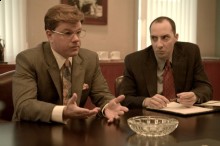
If that sounds a little outre, there’s Steven Soderbergh’s The Informant! (don’t forget the exclamation point, warns the distributor) with Matt Damon, an addle-brained corporate player who thinks that it will actually be good for his career if he blows the whistle on his company’s involvement in price-fixing. It’s based on a true story, too, for what that’s worth. The trailer promises a fairly funny film. The trick is that you never actually know what you’re getting with Soderbergh. OK, this is clearly not in his obscure mode like Full Frontal (talk about pretentious twaddle!), nor is it art-house fare like his two-part Che Guevara biopic. At the same time, it doesn’t really look to be quite in the Ocean’s Eleven realm of mainstream crowd-pleasing. Friday will give us the answer, when it opens at most corporate theaters.
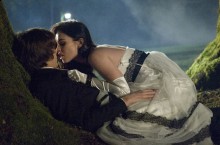
Calling the early word on Jennifer’s Body brutal is something of an understatement—and the venom may well be deserved. Look, director Karyn Kusama gave us Aeon Flux (2005), which is hardly something that induces optimism. Worse, the trailer looks cheesy and obvious. Worse yet, the damned thing stars Megan Fox. None of this bodes well, but I can’t get away from the sense that at least some of this is backlash at screenwriter Diablo Cody, who is being knocked down a peg or two after flying too high too fast with Juno. Apparently, there’s something in human nature that just itches to do this sort of thing, since you see it happen all the time. With this in mind, I’m still interested, but prepared to be less than whelmed.

Now, when you look at this week’s Xpress you’ll note that there’s no mention of a movie called My One and Only opening. That’s because this sneaked into the listings—out of nowhere—several hours after the deadline on upcomers. No, this is not a film version of the Gershwin-filled 1983 stage musical that starred Tommy Tune and Twiggy. Instead, it’s a kind of biopic of the early years of executive producer George Hamilton (the plot synopsis adheres pretty closely to his bio). While I question that there is a crying need for a movie on this topic, I will note that it looks like it could provide the most worthwhile role for Renée Zellweger in ages (as George’s Southern-belle mom). It might also be the most interesting project Richard Loncraine has tackled since he directed Richard III back in 1995. I’m at least intrigued. As near as I can tell, the Beaucatcher has an exclusive on this one.
Word to the wise, Taking Woodstock will be history come Friday, and Extract and Gamer are in sharp decline. (500) Days of Summer is only holding on at the Carolina. In the Loop and Adam will go to split shows at the Fine Arts, while the estimable (but underperforming) World’s Greatest Dad drops to two shows a day at the Carolina. District Nine is still holding its own at some theaters, while Inglourious Basterds is holding up in general.
On DVD

For those of you who missed the wonderful Easy Virtue—perhaps the most playful film of the year—during its theatrical run, it makes a welcome appearance this week on the DVD front. Director Stephan Elliott more than justifies the reputation he earned in 1994 with this (fairly loose) version of an early Noel Coward play, while Jessica Biel truly comes into her own as an actress. There’s fine work from Colin Firth and Kristin Scott Thomas, too. Plus, the film boasts one of the quirkiest—yet completely apt—sound tracks you’ve ever encountered. This should be on the short list of titles to catch up with.
X-Men Origins: Wolverine is also out. I didn’t think this was as bad as most people seemed to—but then I have no investment in the source material. I can’t, however, say that I have any great desire to revisit it. On the other hand, I would actively avoid revisiting Benny Boom’s Next Day Air, which, despite the peculiar endorsement of critic Armond White, was one of the most tedious wastes of talent I encountered all year.
In the special-release realm we find the “Screwhead Edition” of Sam Raimi’s Army of Darkness. Apart from selling the same movie again to fans of Raimi and Bruce Campbell, I’m not real sure why this is out. Perhaps someone who is keener on Raimi than I am will explain. Alan Parker’s Fame is back among us just in time to bone up on the 1980 original before the rather awful-looking remake hits theaters. The same concept was obviously behind the latest DVD incarnation of The Wolf Man, but since the remake has been moved to 2010, the idea is lost—and possibly so is this apparently superfluous DVD. At least for now. The Wolf Man is still listed as coming out today, but it also hasn’t been released yet according to Amazon. In any case, I can see nothing to justify Universal releasing this title a third time.
Notable TV screenings
Those suffering the pangs of thwarted Orangutaniana will be pleased to know that Dunston Checks In returns to Fox Movie channel at 4 p.m. on Sunday, Sept. 20. (Since this is coincidentally my birthday, I’m debating whether to feel honored or insulted by the programming.) Otherwise, we have a week with a few choice titles coming to us via Turner Classic Movies.
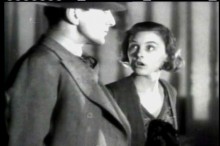
Number Seventeen 6 a.m. Wednesday, Sept 16, TCM
This extremely odd Alfred Hitchcock movie from 1932 is, I fear, little appreciated. I think the blind spot that people have with this title is that they want it to make some kind of narrative sense, which it only barely does—and only if you’re being generous with your definition of “narrative sense.” The movie is as close as Hitch ever came to the “Old Dark House” genre, which makes it interesting from that standpoint alone. The story—such as it is—concerns a diverse group of people ending up at the titular address one gloomy night. It has something to do with a stolen necklace, though it’s hardly clear how or why everyone showed up. There’s also a deaf mute, who, this being Hitchcock, really isn’t, but the reason for the pose is never addressed. None of this really matters, though, because the film is mostly Hitch playing with effects—and very nice ones they are. The last 10 minutes of the film comprise a wild chase involving a train and a bus. It’s sufficiently fun that it’s easy to overlook Hitch indulging his penchant for model work. Actually, the model work is surprisingly good (at least up to the train crashing into a ferry), and the thing that most gives the game away is simply that some shots wouldn’t have been possible any other way.

Strange Cargo 6 p.m. Friday, Sept. 18, TCM
Frank Borzage’s Strange Cargo (1940) is nothing if not strange. It may in fact be the weirdest and most personal picture to come out of MGM during the post-code era of the studio system. Borzage’s filmography tends toward a very personal mystical religious tone, but I’m pretty sure this is the only of his films where it’s very possible that one of the characters—an escapee (Ian Hunter) from a French penal colony—actually is God. (That’s certainly the conclusion Clark Gable’s character draws at one point.) That, however, is not the only reason the film is strange, since, for what is clearly a spiritual work, Strange Cargo is also a heavily sexualized film. (Just watch the fetish-ized attitude Gable takes toward Joan Crawford’s lipstick-stained cast-off cigarette.) It may not be quite in the same league as the films Borzage made when he had something like complete autonomy at Fox in the waning days of silents and the early days of sound, but it’s not that far from it.
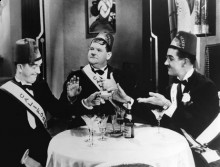
Sons of the Desert 6 a.m. Saturday, Sept. 19, TCM
Sons of the Desert (1933) is generally considered to be the best feature film ever made by Stan Laurel and Oliver Hardy—with Way Out West (1937) being its most serious competition. I’d probably agree if it hadn’t been the only feature film I owned (on Super 8 sound, no less) for over a year, which is to say that I’ve seen it a few too many times to want to sit through it again more than every few years. Assuming you haven’t seen it to death, it likely is the closet the Boys ever came to capturing the essence of their short films in a feature. It has the tone of a short film, with its simple premise that finds Stan and Ollie concocting a wild scheme that allows them to bamboozle their wives and sneak off to the annual convention of their fraternal order, the Sons of the Desert. The problem with their plan is that the ship they’re supposed to be on sinks in a typhoon, and the jig is up when their distraught wives go to a movie and see newsreel footage of the pair at the convention. (Actually, the premise is taken from their 1928 short We Faw Down and elaborated on.) The film is beautifully crafted, and the results produce one of the true classics of the comedy film.
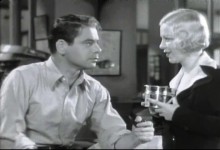
Hi, Nellie! 8:15 a.m. Tuesday, Sept. 22, TCM
Paul Muni was the prestige star at Warner Bros. after George Arliss departed with producer Darryl F. Zanuck when the latter left to form 20th Century Pictures, but early on Muni was occasionally allowed to star in less overtly “artistic” roles. Mervyn Leroy’s Hi, Nellie! (1934) is probably the most laid-back movie of his career—and one of the most enjoyable. It’s a pretty straightforward newspaper comedy/mystery that features Muni as a fast-talking, wise-cracking newspaperman (was there any other kind in the 1930s), who comes a cropper on a big story and is demoted to the “Heart Throb” column as Nellie Nelson, giving advice to the lovelorn. Naturally, it’s through this loathsome assignment that he hits on the biggest story in ages and finds his path back to the big league. It’s hardly earthshaking stuff, but it’s slick, fast and funny—and helped no end by a supporting cast of pros like Glenda Farrell, Ned Sparks, Berton Churchill and Douglass Dumbrille. (And if you don’t know who they are, you need to catch up on your 1930s movies.) Plus, it’s just nice to see Muni not hiding behind a crepe beard or a dialect for a change.




There is a big dvd out today for art house fans: Peter Greenaway’s NIGHTWATCHING. I run hot or cold with Greenaway, but I think that this is one of his best.
Also, MPI FINALLY decided to start making some money and is now packaging the Basil Rathbone Sherlock Holmes films as double features at a reduced price. Two sets are available now.
TOO many tv shows to mention, but the best is IT’S ALWAYS SUNNY IN PHILADELPHIA SEASON 4. If you haven’t seen this show yet, you need to.
Ken might not be, but I’m sure happy that they decided to finally release PHANTASM II. The first film was a huge part of my childhood and this sequel delivers the goods with more about the mythology and of course, more Reggie.
Sons of the Desert (1933) is generally considered to be the best feature film ever made by Stan Laurel and Oliver Hardy—with Way Out West (1937) being its most serious competition.
I still retain a fondness for MARCH OF THE WOODEN SOLDIERS.
There is a big dvd out today for art house fans: Peter Greenaway’s NIGHTWATCHING. I run hot or cold with Greenaway, but I think that this is one of his best.
I confess to having missed the fact that this was a Greenaway picture. What films of his would you liken it to? (This will have great bearing on my level of interest.)
Ken might not be, but I’m sure happy that they decided to finally release PHANTASM II.
I have nothing against the Phantasm movies. In fact, I like them better than the Evil Dead movies. (The Evil Dead stuff always feel self-conscious. Phantasm really feels like terrific drive-in trash. In fact when the first film came out, I told a friend to see it, saying, “It’s everything you hope a drive-in movie will be and almost never is.”)
I confess to having missed the fact that this was a Greenaway picture. What films of his would you liken it to? (This will have great bearing on my level of interest.)
That’s just it… I really can’t compare it to anything else he’s done. His “style” is still there, from bold color changes during the scene to the shot being framed like a painting. To be honest, he lost me in the 90s. I enjoy watching his films, but I found most of them pretentious and pointless. This is my favorite of his since THE COOK, THE THIEF HIS WIFE AND HER LOVER.
I still retain a fondness for MARCH OF THE WOODEN SOLDIERS.
And here I took you for a Fra Diavolo man.
To be honest, he lost me in the 90s. I enjoy watching his films, but I found most of them pretentious and pointless.
Since we got much of this stuff out of order and later than it was made, I’m not sure what you mean by 90s. My personal favorites are Prospero’s Books and A Zed and Two Noughts. I’m okay with most of the theatrical films, except I don’t get the appeal of Belly of an Architect at all, and loathed Baby of Macon (a decent copy might help, but I doubt it).
As for them being pretentious, I’ve finally decided that pretentious is not a dirty word. In a world filled with Will Ferrell and the Wayans and all the rest of the lowest common denominator stuff that gets churned out each year, I’m pretty cool with pretentious. Pointless is harder to excuse, though I’ve never thought of Greenaway as particularly deep (that would include Cook, Thief). I more think of him as someone who makes stylish, adult entertainments.
I agree with everything you’ve said Ken. Actually, Greenaway’s films have held up for me and I’ve warmed slightly to THE PILLOW BOOK and 8 1/2 WOMEN.
You’ll definitely like this new one. A ZED AND TWO NOUGHTS was the first I ever saw and still probably my fave. I need to see DROWNING BY NUMBERS again.
I need to see DROWNING BY NUMBERS again.
Me too. Unfortunately — like so many Greenaway films — it seems not to be available on DVD. I have the laserdisc. What I do not have at the moment is a working laserdisc player.
In any case, I’ll be checking out this new one.
What I do not have at the moment is a working laserdisc player.
I do!
I do!
Well, I have Drowning by Numbers — and, in a different vein, Hanif Kureishi’s sole directorial effort London Kills Me — just waiting to be burned to DVD-R. Both are, I’m pretty sure, full-frame, alas.
Congratulations on surviving your reviewing marathon! Ironically, as I read this week’s reviews, I thought they were especially acute and well-written. I guess you work best under a heavy load!
I’m pretty cool with pretentious. Pointless is harder to excuse
My definition of pretension includes pointlessness — what I call “non-functional stylistic excess”.
That said, I am a devout auteurist and a forest-for-the-trees kind of guy, so style is one of my paramount concerns in movie-viewing. I just have very little patience for fussy direction.
Congratulations on surviving your reviewing marathon! Ironically, as I read this week’s reviews, I thought they were especially acute and well-written. I guess you work best under a heavy load!
Let’s hope so, because with early screenings and special showings this week is even heavier. I will admit that the pickings by and large look more enticing, however.
My definition of pretension includes pointlessness—what I call “non-functional stylistic excess”.
I’m generally okay with that, too — as long as the filmmaker realizes that’s what he’s doing. It’s more the delusion that a film is being somehow profound that gets the pretension tag from me. But I’m gaining patience with that in some areas — if only because there are things I think are profound that I know others find pretentious. More and more it seems to be an empty word used to dismiss something with a minimum of effort. I’m about to put it on the level of “self-indulgent,” “classic” (and its peculiar partner “instant classic”) and “visionary” as words that have no — or have lost their — meaning.
I’m generally okay with that, too — as long as the filmmaker realizes that’s what he’s doing.
You’re right; I should have added that qualification.
At the same time, I find it impossible to explain how I distinguish between deliberate excess and unthinking excess. As an analytical person, it frustrates me that I can’t codify such a basic distinction.
For instance, I thought that the protracted sex scene in Watchmen was unintentionally hilarious. Zach Snyder claims that he intended it to be “cheesy”. But the knowledge of his intent doesn’t change my impression that the cheese was unintentional.
As a pretty cerebral critic, do you have any insight into the process whereby we divine (or believe we divine) directorial intent?
At the same time, I find it impossible to explain how I distinguish between deliberate excess and unthinking excess. As an analytical person, it frustrates me that I can’t codify such a basic distinction.
Well, it’s not entirely possible, you know. I mean, take something like Josef von Sternberg’s The Scarlet Empress (1934). Sternberg himself called it “a relentless excursion into style,” so you’ve got that as a starting point. Then you find yourself faced with a montage of Tsarist barbarism and torture as soon as the movie starts. By the time you get to Dietrich’s Catherine the Great surveying a line of soldiers with her eyes darting down to check out the basket of ever man she passes, you’re on pretty firm ground that this is deliberate. When she — and a whole lot of soldiers — clatter up the inside staircases on horseback into the throne room and the “1812 Overture” erupts on the soundtrack, with the film ending with her grinning just like her recently murdered madman of a husband, you know this is intentional. But that’s an extreme case — and we start from the director telling you it’s all about style.
For instance, I thought that the protracted sex scene in Watchmen was unintentionally hilarious. Zach Snyder claims that he intended it to be “cheesy”. But the knowledge of his intent doesn’t change my impression that the cheese was unintentional.
No, no, it’s not the “knowledge of his intent,” it’s the knowledge of him claiming intent. The two things are not interchangeable, and the statement wasn’t made until after the scene went over rather badly. Based on Snyder’s work to date, I have a hard time imagining his ability to judge cheese.
As a pretty cerebral critic, do you have any insight into the process whereby we divine (or believe we divine) directorial intent?
Well, if I had several hours to devote to this, we could start to scratch the surface, but…you’re always going to be guessing or go on a feeling to some degree. The more you know of a filmmaker’s work, the greater the chances are that you can make a pretty good call. The more you know of the filmmaker personally will probably reveal other things, but that’s pretty rare. (By personally, I mean really know him or her, not just fancy that you do because you’ve been to a Q&A or have read a lot about them.)
Now, having said all that, you’re also up against the very real prospect that the intent is possibly as much intuitive and conscious. If it is intuitive, is it really any less intentional on some level? Easy example — about 27 years ago when I was writing Ken Russell’s Films, I got this weird feeling about the structure of Tommy. I had noticed that the film’s opening consists of seven shots and that it’s closing also consists of seven shots. More, I realized that the two sequences are essentially mirror images with the last shot being a variation of the first one. (This, by the way, is key to reading the film, I think.) But I also noticed that the most frenetically structured individual sequence, the “Pinball Wizard” number, occurred at the film’s midway point. So I did what any self-respecting obsessive would do and sat down and counted the shot breakdown of each sequence. Now, exempting brief scenes used for bridging purposes, what I found was the scenes build in complexity (in terms of editing) up to “Pinball Wizard,” and that afterwards they become increasingly less so, until we get back to those seven shots. In a sense, you climb to a peak and then work your way back down. This is demonstrable — assuming you’re nuts enough to do it. (It would be easier now than it was then when I was working from a 16mm print.) Naturally, I asked KR whether he had planned this. He said, no, he hadn’t, then added “at least not consciously.” So is it intentional? My feeling is that it is, but on an intuitive level. And since we are dealing with art, intuition plays a valuable role, don’t you think? And is your own intuition in reading the film any less valuable? I don’t think that anything that jogs a viewer into looking at something in a new light is without merit.
Well, it’s not entirely possible, you know.
Now, see here, Mr. Hanke, I come to you for answers. That’s not the answer for which I was looking.
the statement wasn’t made until after the scene went over rather badly.
See, I didn’t have any context for that statement.
Based on Snyder’s work to date, I have a hard time imagining his ability to judge cheese.
Yes, well, based on his work to date, I have a hard time imagining his ability to point a camera.
Now, having said all that, you’re also up against the very real prospect that the intent is possibly as much intuitive and conscious.
Now that idea, I certainly understand. Vladimir Nabokov relied so heavily on synaesthetic associations that he acknowledged the validity of interpretations of his work that he hadn’t consciously intended.
So I did what any self-respecting obsessive would do and sat down and counted the shot breakdown of each sequence.
The intensity of your devotion astonishes me — and as a Star Wars fan, I don’t say that lightly. Or without some measure of awed admiration.
I don’t think that anything that jogs a viewer into looking at something in a new light is without merit.
In that case, do you think that there’s any merit to the idea that Chris Columbus’ Harry Potter and the Chamber of Secrets was one big crypto-Freudian exploration of puberty? Or does that interpretation cross the line into projection?
(You’re going to ask for clarification, and when I spell it out for you, you’re going to regret asking.)
(You’re going to ask for clarification, and when I spell it out for you, you’re going to regret asking.)
You know, I might have left this alone if I hadn’t sat through Cloudy with a Chance of Meatballs (and I wasn’t reviewing it), which has more Freudian sex imagery in it than a pre-code Betty Boop cartoon. As a result, I’m asking — and am prepared to take my chances.
Ron and Harry discover a secret passage in the girl’s bathroom and descend a slimy tunnel, where Ron is unable to continue because his wand is broken, its tip dangling limply. Harry proceeds into a damp chamber, where he kills a giant snake with a sword that magically extends out of a hat. He then stabs a diary with an enormous fang that’s spewing venom.
And the reason they’re undertaking this quest? To save the girl whom Harry eventually marries and upon whom he fathers three children.
Now, why was I going to regret asking? Here’s the thing,what you say is pretty convincing to me — as a perfectly reasonable reading. What I can’t say — I haven’t seen the film since it came out (I think the studio sent me a copy, which is probably somewhere) — so I can’t be sure how much I’m being influenced by the way you phrased your theoretical interpretation. You may have gilded the lily a bit there. In your favor, I had already assumed this was going to involve the bathroom and the snake as soon as you suggested this reading. That says to me that there’s something to it. My biggest surprise is that you haven’t put forth the idea that the very title — Chamber of Secrets — could indeed refer to the female private parts, especially for someone Harry’s age.
Immediate questions arise — Is Chris Columbus really this damn smart and/or deep? How detailed is the book (or screenplay) on these points? Could all this sexuality be in the material with Columbus only following its dictates?
Mind, I don’t actually believe that interpretation — neither the screenplay nor the novel supports it — but it amuses me to defend untenable theories. Charles Fort, one of my personal heroes, tended vast gardens of gilded lilies.
As an anthropologist, I think that the whole business of reading elaborate sexual symbolism into fairy tales is intellectually bankrupt. On the other hand, fantasy does offer an abundance of potential phallic symbols — swords and wands and maidens imprisoned in, ahem, tall towers — so I can see the appeal of the Freudian scheme.
I’m interested to hear what symbolism you saw in Cloudy with a Chance of Meatballs; Mr. Souther’s review didn’t mention anything.
Mind, I don’t actually believe that interpretation
Well, that’s a letdown.
neither the screenplay nor the novel supports it
But does the film?
As an anthropologist, I think that the whole business of reading elaborate sexual symbolism into fairy tales is intellectually bankrupt.
I’m curious as to why you necessarily take that view.
I’m interested to hear what symbolism you saw in Cloudy with a Chance of Meatballs
Think early 30s Betty Boop. The film is full of long, squishy objects and eruptions of various thick liquids. At one point a new business opens in the town of Chew and Swallow (no comment) with the name “House of Cumin.” Yes, I know that cumin is a spice, but why choose that one? Why not “House of Cardamom” or even “House of Dill Weed?”
I’m curious as to why you necessarily take that view.
I should clarify that I’m referring to the trend (coincident with the rise of Freudian psychoanalysis) of imposing arbitrary sexual symbolism on fairy tales. Certainly, I can think of fairy tales with obvious symbolic trappings.
But there’s a difference between realizing the sexual undertones in “Little Red Riding Hood”, which are very overt in earlier versions, and deciding that the cow in “Jack and the Beanstalk” represents maternal tyranny, an idea for which there is little if any support in the story itself.
Nevertheless, I take the Structuralist view that human psychology imprints on culture, so I allow that the ancient storyteller might have been guided by subconscious associations. As you said, the creation of art is an instinctual process.
Think early 30s Betty Boop.
Ah, I think I get the idea.
The film is full of long, squishy objects and eruptions of various thick liquids.
All of this talk of sexual symbolism in myth had me thinking of Aronofsky’s Fountain. Given its explicit evocation of fertility myth in the form of the Sacred Tree, I think it very likely that the resemblance of the tree’s sap to semen is deliberate.
But does the film?
In order to answer that question authoritatively, I would have to rewatch the film, an activity for which I have not the time nor the patience nor the depths of masochism. Based on the level of depth in l’œvre de Chris Columbus (or should that be l’odeur?), I’m inclined to think not.
(Hey, I’m beginning to see your point about how knowledge of a filmmaker can inform your judgment of whether he intends symbolism.)
I do think that Harry Potter has vague sexual undertones (we are, after all, talking about a series whose protagonist is imprisoned in a closet because of his “unnatural” proclivities and whose mentor is a flamboyant homosexual — as though anyone needed authorial confirmation of that detail), but Rowling herself has said that although that reading is valid in a general sense, she didn’t intend a detailed allegory and that the undertones result from the series’ preoccupation with outsiders and social stigma.
Which, in my opinion, is the way that symbolism should work: it should be an outgrowth of a story’s material details.